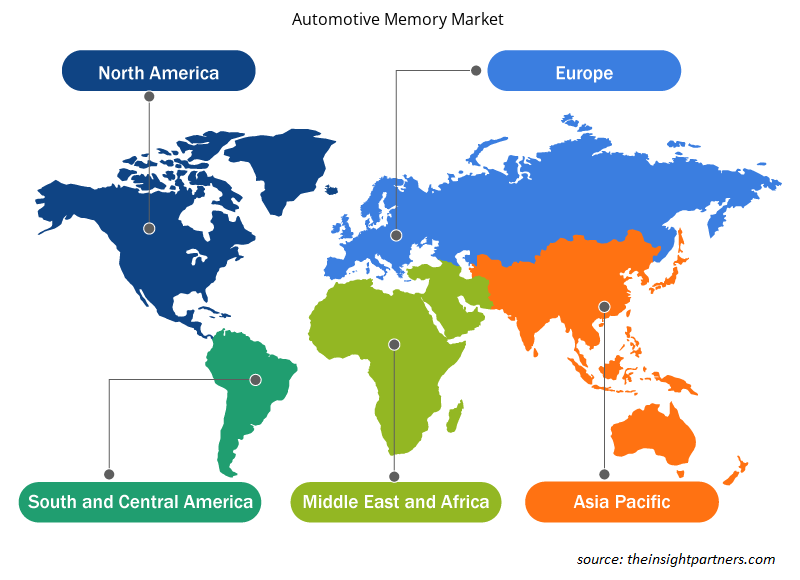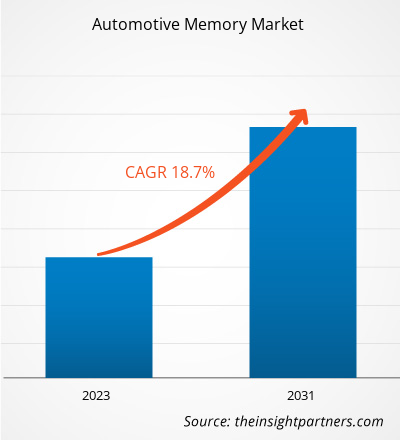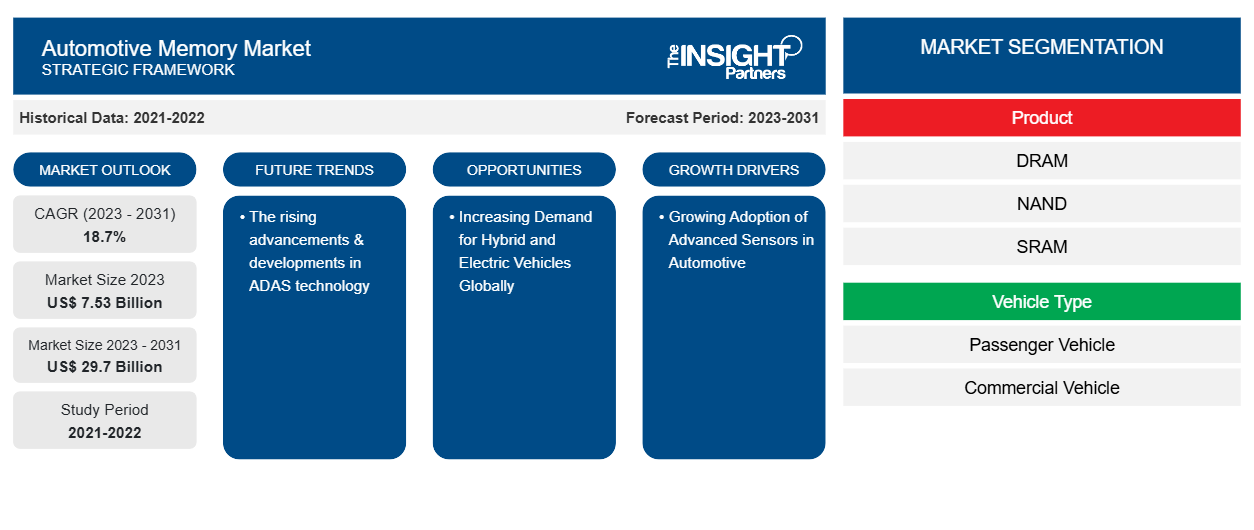Se prevé que el tamaño del mercado de memorias para automóviles alcance los 29 700 millones de dólares en 2031, frente a los 7530 millones de dólares en 2023. Se espera que el mercado registre una CAGR del 18,7 % durante el período 2023-2031. Es probable que los avances y desarrollos crecientes en la tecnología ADAS sigan siendo tendencias clave en el mercado.
Análisis del mercado de memorias para automóviles
Se espera que el aumento de la demanda de telemática automotriz y la adopción de sensores en aplicaciones automotrices impulsen la demanda de memoria automotriz, lo que a su vez se espera que impulse el crecimiento del mercado en los próximos años. Además, se proyecta que las estrictas normas gubernamentales con respecto a la implementación de la telemática en los vehículos impulsarán el crecimiento del mercado entre 2023 y 2031. Además, se espera que la creciente demanda de vehículos eléctricos híbridos y vehículos eléctricos en todo el mundo impulse la demanda de memorias automotrices, lo que a su vez se proyecta que creará oportunidades para las empresas clave en el mercado durante el período de pronóstico.
Descripción general del mercado de memorias para automóviles
En la actualidad, los vehículos están integrados con una variedad de tipos de memoria distribuida, como la memoria de acceso aleatorio estática, la memoria de acceso aleatorio dinámica, la memoria de solo lectura , FLASH y, en algunos casos, la memoria de acceso aleatorio magnetorresistiva (MRAM). Pruebas. El almacenamiento automotriz es similar en función al almacenamiento comercial, pero funciona de manera diferente. Es más similar a las memorias ECC (código de corrección de errores), que se basan en el resultado del acceso a la memoria y la información almacenada es correcta. A medida que se utilizan más microprocesadores, se utiliza DRAM distribuida, que es responsable localmente del procesamiento de señales e información y del almacenamiento SRAM o FLASH para transferir información entre funciones en el vehículo.
La nueva arquitectura automotriz incluye una unidad central de procesamiento (CPU) primaria centralizada con una enorme matriz de memoria comparable a la de un ordenador normal. Basándose en los datos de todos los subsistemas de asistencia al conductor, motor y transmisión, esta unidad procesa y toma decisiones sistémicas. A diferencia de los ordenadores domésticos y comerciales, que tienen una vida útil de entre 2 y 5 años, el almacenamiento del automóvil debe funcionar de forma continua durante 12 a 20 años.
Personalice este informe según sus necesidades
Obtendrá personalización en cualquier informe, sin cargo, incluidas partes de este informe o análisis a nivel de país, paquete de datos de Excel, así como también grandes ofertas y descuentos para empresas emergentes y universidades.
- Obtenga las principales tendencias clave del mercado de este informe.Esta muestra GRATUITA incluirá análisis de datos, desde tendencias del mercado hasta estimaciones y pronósticos.
Factores impulsores y oportunidades del mercado de memorias para automóviles
La creciente adopción de sensores avanzados en la industria automotriz favorece el mercado
Los sensores automotrices son esenciales para el buen funcionamiento de los automóviles modernos. Estos sensores proporcionan información sobre numerosos parámetros del vehículo a la unidad de control electrónico (ECU), maximizando la seguridad, la eficiencia y el rendimiento. Lo hacen convirtiendo cantidades físicas en impulsos eléctricos. Estos sensores se clasifican en dos categorías principales: primero, por las propiedades físicas que miden, y segundo, por la tecnología subyacente que utilizan. Los sensores ayudan a reducir los errores causados por el desgaste o la contaminación, garantizan mediciones estables y ahorran espacio en entornos de alta temperatura. Se espera que la demanda de sensores de presión aumente e impulse la industria rápidamente. Los sensores de presión se instalan en las puertas laterales del automóvil que envían señales digitales de colisión a la unidad central del airbag para prevenir accidentes. Por lo tanto, se espera que el aumento en la adopción de sensores avanzados en aplicaciones automotrices impulse el crecimiento del mercado en los próximos años.
Creciente demanda de vehículos híbridos y eléctricos a nivel mundial
El aumento de los vehículos totalmente eléctricos (VE) y los vehículos eléctricos híbridos, acompañado de la aparición de los sistemas ADAS, los cuadros de instrumentos gráficos (GIC), los sistemas de infoentretenimiento y las soluciones de conducción totalmente autónoma, ha creado una demanda de unidades de control electrónico (ECU), controladores automotrices utilizados para recibir y procesar señales de los sensores y enviar comandos de control al actuador para su ejecución. Por ejemplo, en los EE. UU., los nuevos automóviles eléctricos registrados en el año 2023 ascendieron a ~1.400.000 unidades, un aumento del 40 % en comparación con 2022. Se espera que este aumento de la demanda de vehículos eléctricos cree una oportunidad para los actores clave que operan en el mercado de memorias para automóviles.
Análisis de segmentación del informe de mercado de memoria automotriz
Los segmentos clave que contribuyeron a la derivación del análisis del mercado de memoria automotriz son el producto, el tipo de vehículo y la aplicación.
- Según el producto, el mercado de memoria automotriz se divide en DRAM, NAND, SRAM, NOR y otros. El segmento DRAM tuvo la mayor participación de mercado en 2023.
- Por tipo de vehículo, el mercado se segmenta en vehículos de pasajeros y vehículos comerciales. El segmento de vehículos de pasajeros tuvo la mayor participación del mercado en 2023.
- Por aplicación, el mercado se clasifica en infoentretenimiento y conectividad, ADAS y otros. El segmento otros tuvo una participación significativa del mercado en 2023.
Análisis de la cuota de mercado de memorias para automóviles por geografía
El alcance geográfico del informe del mercado de memoria automotriz se divide principalmente en cinco regiones: América del Norte, Asia Pacífico, Europa, Medio Oriente y África, y América del Sur y Central.
El alcance del informe sobre el mercado de memorias para automóviles abarca América del Norte (EE. UU., Canadá y México), Europa (España, Reino Unido, Alemania, Francia, Italia y el resto de Europa), Asia Pacífico (Corea del Sur, China, India, Japón, Australia y el resto de Asia Pacífico), Oriente Medio y África (Sudáfrica, Arabia Saudita, Emiratos Árabes Unidos y el resto de Oriente Medio y África) y América del Sur (Brasil, Argentina y el resto de América del Sur). En términos de ingresos, Asia Pacífico dominó la cuota de mercado de memorias para automóviles en 2023. América del Norte es el segundo mayor contribuyente al mercado mundial de memorias para automóviles, seguido de Europa.
Perspectivas regionales del mercado de memorias automotrices
Los analistas de Insight Partners explicaron en detalle las tendencias y los factores regionales que influyen en el mercado de memorias automotrices durante el período de pronóstico. Esta sección también analiza los segmentos y la geografía del mercado de memorias automotrices en América del Norte, Europa, Asia Pacífico, Oriente Medio y África, y América del Sur y Central.

- Obtenga datos regionales específicos para el mercado de memoria automotriz
Alcance del informe sobre el mercado de memorias para automóviles
| Atributo del informe | Detalles |
|---|---|
| Tamaño del mercado en 2023 | 7.530 millones de dólares estadounidenses |
| Tamaño del mercado en 2031 | US$ 29,7 mil millones |
| CAGR global (2023 - 2031) | 18,7% |
| Datos históricos | 2021-2022 |
| Período de pronóstico | 2023-2031 |
| Segmentos cubiertos | Por producto
|
| Regiones y países cubiertos | América del norte
|
| Líderes del mercado y perfiles de empresas clave |
|
Densidad de actores del mercado de memorias automotrices: comprensión de su impacto en la dinámica empresarial
El mercado de memorias para automóviles está creciendo rápidamente, impulsado por la creciente demanda de los usuarios finales debido a factores como la evolución de las preferencias de los consumidores, los avances tecnológicos y una mayor conciencia de los beneficios del producto. A medida que aumenta la demanda, las empresas amplían sus ofertas, innovan para satisfacer las necesidades de los consumidores y aprovechan las tendencias emergentes, lo que impulsa aún más el crecimiento del mercado.
La densidad de actores del mercado se refiere a la distribución de las empresas o firmas que operan dentro de un mercado o industria en particular. Indica cuántos competidores (actores del mercado) están presentes en un espacio de mercado determinado en relación con su tamaño o valor total de mercado.
Las principales empresas que operan en el mercado de memoria automotriz son:
- Tecnología Micron Inc.
- Samsung Electronics Co., Ltd.
- Corporación Toshiba
- Tecnologías digitales occidentales, Inc.
- SK Hynix
- Compañía Macronix Internacional
Descargo de responsabilidad : Las empresas enumeradas anteriormente no están clasificadas en ningún orden particular.

- Obtenga una descripción general de los principales actores clave del mercado de memoria automotriz
Noticias y desarrollos recientes del mercado de memorias para automóviles
El mercado de memorias para automóviles se evalúa mediante la recopilación de datos cualitativos y cuantitativos a partir de una investigación primaria y secundaria, que incluye publicaciones corporativas importantes, datos de asociaciones y bases de datos. A continuación, se enumeran algunos de los avances en el mercado de memorias para automóviles:
- Samsung Electronics Co., Ltd. firmó un acuerdo con SemiDrive. Mediante este acuerdo, Samsung Electronics Co., Ltd. suministrará soluciones de memoria para automóviles a SemiDrive. (Fuente: Samsung Electronics Co., Ltd., comunicado de prensa, agosto de 2023)
- Samsung Electronics Co., Ltd. desarrolló una nueva memoria DRAM GDDR7 de 32 Gbps. Este nuevo producto de memoria automotriz ampliará las capacidades en aplicaciones para IA, HPC y vehículos automotores. (Fuente: Club Car, comunicado de prensa, marzo de 2023)
Informe sobre el mercado de memorias automotrices: cobertura y resultados
El informe “Tamaño y pronóstico del mercado de memoria automotriz (2021-2031)” proporciona un análisis detallado del mercado que cubre las siguientes áreas:
- Tamaño del mercado de memoria automotriz y pronóstico a nivel global, regional y nacional para todos los segmentos clave del mercado cubiertos bajo el alcance
- Tendencias del mercado de memoria automotriz, así como dinámica del mercado, como impulsores, restricciones y oportunidades clave
- Análisis PEST y FODA detallados
- Análisis del mercado de memoria automotriz que cubre las tendencias clave del mercado, el marco global y regional, los principales actores, las regulaciones y los desarrollos recientes del mercado.
- Análisis del panorama de la industria y de la competencia que abarca la concentración del mercado, el análisis de mapas de calor, los actores destacados y los desarrollos recientes del mercado de memorias automotrices
- Perfiles detallados de empresas
- Análisis histórico (2 años), año base, pronóstico (7 años) con CAGR
- Análisis PEST y FODA
- Tamaño del mercado, valor/volumen: global, regional y nacional
- Industria y panorama competitivo
- Conjunto de datos de Excel
Informes recientes
Testimonios
Razón para comprar
- Toma de decisiones informada
- Comprensión de la dinámica del mercado
- Análisis competitivo
- Información sobre clientes
- Pronósticos del mercado
- Mitigación de riesgos
- Planificación estratégica
- Justificación de la inversión
- Identificación de mercados emergentes
- Mejora de las estrategias de marketing
- Impulso de la eficiencia operativa
- Alineación con las tendencias regulatorias





















 Obtenga una muestra gratuita para - Mercado de memorias automotrices
Obtenga una muestra gratuita para - Mercado de memorias automotrices